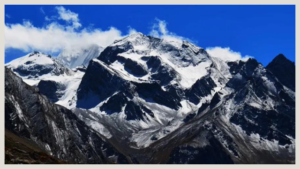Physical Address
23,24,25 & 26, 2nd Floor, Software Technology Park India, Opp: Garware Stadium,MIDC, Chikalthana, Aurangabad, Maharashtra – 431001 India
Physical Address
23,24,25 & 26, 2nd Floor, Software Technology Park India, Opp: Garware Stadium,MIDC, Chikalthana, Aurangabad, Maharashtra – 431001 India

In what seems to be a first of its kind visible impact of climate change in the Indian Himalayan Region, Om Parvat, a sacred mountain in Uttarakhand’s Vyas Valley known for its snow-covered ‘Om’ shape, became completely free of snow last week. This was the first time in recorded history when snow has completely disappeared from the mountain, multiple reports said. Located at an altitude of approximately 14,000 feet, Om Parvat is popular among tourists and pilgrims for its snow-covered peak that naturally forms a pattern resembling the Sanskrit word ॐ (Om), after which it is named.
The disappearance of snow from Om Parvat highlights the severe impacts of climate change on the fragile Himalayan ecosystem. Rising global temperatures have caused glacier melting and reduced snowfall, threatening the region’s natural beauty and water supply for millions. This situation underscores the urgent need for measures to protect the Himalayan environment. The fact that the state of Uttarakhand is witnessing a significant rise in cases of wildfires in recent times might also be an important factor.
Apart from this, the surge in tourist footfall in the region leading to increased vehicular emissions is another factor that might have contributed to the complete disappearance of the snow. While snow seems to have come back after fresh snowfall on August 26 night, it might be nothing but a momentary relief from the fears of the region’s future in a rapidly warming world.
What are the experts saying?
According to Anand Sharma, a retired additional director general of the India Meteorological Department, “100-year data collected between 1901 and 2001 in Uttarakhand suggests a one-degree temperature increase in the period.” Sharma, who also heads the Indian Meteorological Society (IMS) added, “Also there have been incidents of forest fires in the summers and that could have possibly led to the formation of carbon that could have prompted the melting of snow and this needs to be researched.”
Director of GB Pant National Institute of Himalayan Environment, Sunil Nautiyal, reportedly cited the two main factors as ‘the growing number of fuel-powered vehicles in the region and the broader effects of global warming.’ “To check this, we will have to determine the bearing capacity of all sensitive places of the high Himalayan region as well as rampant forest fires as carbon generated by forest fires is also damaging the sensitive spots in the Himalayan region,” Nautiyal said.
Dilip Kumar Rai, environmentalist, Sikkim, reportedly said, “The complete disappearance of snow from Om Parvat for the first time is a significant environmental marker, reflecting broader changes happening across the Himalayas.” Rai mentioned the immediate factor as a “warming climate.” He said, “Studies have shown that the Himalayan region is warming at a rate faster than the global average. As temperatures rise, the snowline retreats, and glaciers and snow caps that were once permanent are now shrinking or disappearing.”
Rai reportedly also highlighted that the change in precipitation patterns have played a significant role in this. The Himalayan region has experienced a shift from snowfall to rainfall during the colder months, leading to reduced snow accumulation on peaks like Om Parvat.
“Glacial retreat, reduced snowfall, and changes in monsoon patterns are all interconnected consequences of global warming and local environmental impacts. For Om Parvat, these broader changes mean that its snow cover is no longer stable, reflecting a larger crisis in the region’s climate health,” Rai added.
This is happening across the world
Snow is rapidly disappearing from mountains across the world due to the accelerating effects of climate change. This shift is leading to the shrinking of glaciers and the retreat of snowlines on many iconic mountains.
In the European Alps, for example, glaciers have lost a substantial portion of their ice mass over the past century. The Mont Blanc massif, known for its snow-covered peaks, is experiencing reduced snowfall and faster melting of glaciers.
In North America, the Rocky Mountains and the Sierra Nevada are also witnessing declining snowpacks. Warmer winters have led to earlier snowmelt, reducing the snow cover that sustains river flows and reservoirs during the dry summer months.
In the Andes, the situation is similarly dire. Glaciers in the Peruvian Andes, such as the Quelccaya Ice Cap, are retreating rapidly.
In Africa, Mount Kilimanjaro’s iconic snowcap has been steadily vanishing, with scientists predicting that it could disappear entirely within a few decades.
The disappearance of snow from these mountains is more than just a loss of natural beauty; it is a clear warning of the far-reaching consequences of climate change. The melting of glaciers and snowpacks disrupts ecosystems, threatens water security, and increases the risk of natural disasters such as floods and landslides.
References:
Climate Change may lead to decreased water flow in Himalayan Glaciers
A ‘Himalayan’ Crisis: Understanding Wildfires in Uttarakhand and India
https://www.tandfonline.com/doi/full/10.1080/00963402.2024.2364501
https://www.nesdis.noaa.gov/news/sierra-nevada-snowpack-the-decline